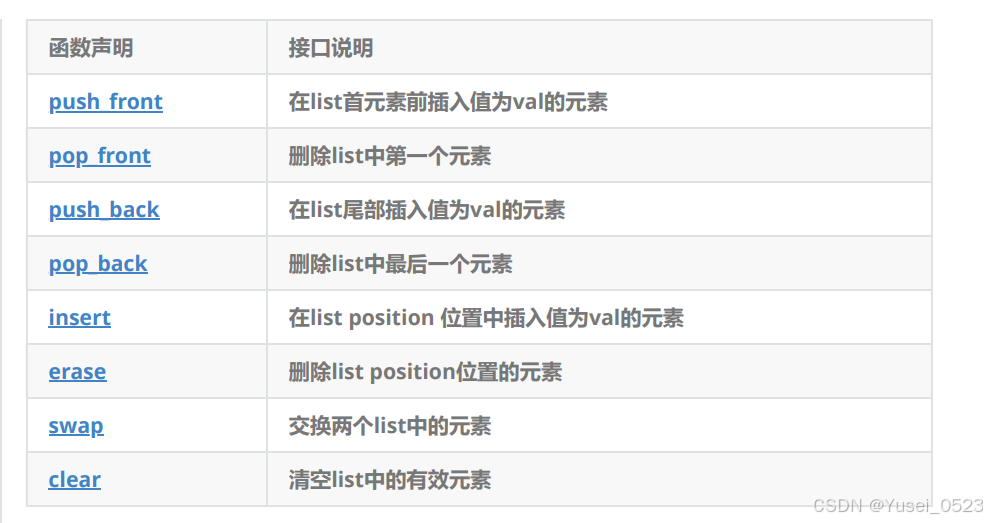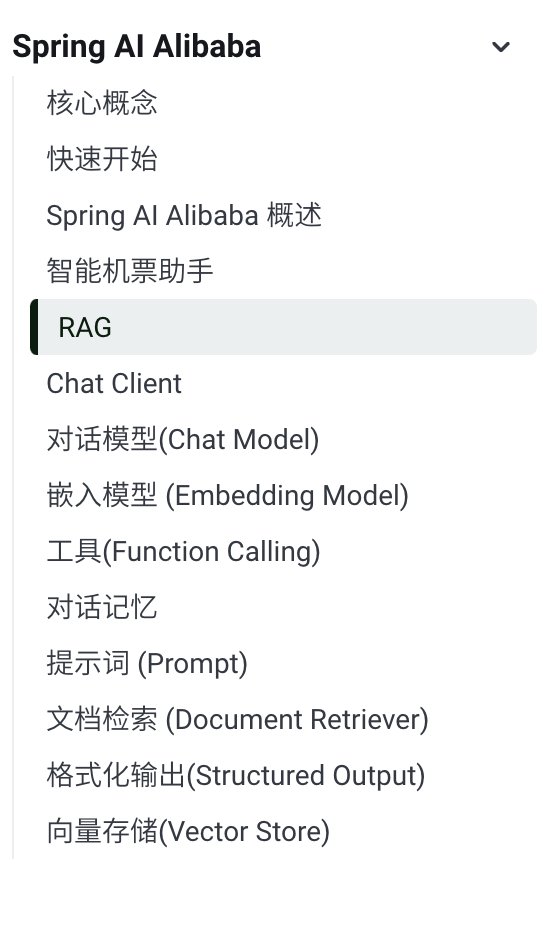list_1">1. list的介绍及使用
list_2">1.1 list的介绍

list_4">1.2 list的使用
list_5">1.2.1 list的构造

list_iterator_8">1.2.2 list iterator的使用
此处,大家可暂时将迭代器理解成一个指针,该指针指向list中的某个节点。


【注意】
- begin与end为正向迭代器,对迭代器执行++操作,迭代器向后移动
- rbegin(end)与rend(begin)为反向迭代器,对迭代器执行++操作,迭代器向前移动
list_capacity_20">1.2.3 list capacity

list_element_access_22">1.2.4 list element access

list_modiers_26">1.2.5 list modifiers

list_30">1.2.6 list的迭代器失效
前面说过,此处大家可将迭代器暂时理解成类似于指针,迭代器失效即迭代器所指向的节点的无
效,即该节点被删除了。因为list的底层结构为带头结点的双向循环链表,因此在list中进行插入
时是不会导致list的迭代器失效的,只有在删除时才会失效,并且失效的只是指向被删除节点的迭
代器,其他迭代器不会受到影响。
使用接口
#include<iostream>
#include<algorithm>
#include<list>
#include<vector>
using namespace std;
void test_list1()
{list<int> lt;lt.push_back(1);lt.push_back(2);lt.push_back(3);lt.push_back(4);list<int>::iterator it = lt.begin();while (it != lt.end()){cout << *it << " ";++it;}cout << endl;for (auto e : lt){cout << e << " ";}cout << endl;}
支持迭代器就支持范围for
struct A
{
public:A(int a1 = 1, int a2 = 1):_a1(a1), _a2(a2){cout << "A(int a1 = 1, int a2 = 1)" << endl;}A(const A& aa):_a1(aa._a1), _a2(aa._a2){cout << "A(const A& aa)" << endl;}int _a1;int _a2;
};
void test_list2()
{list<A> lt;A aa1(1, 1);lt.push_back(aa1);lt.push_back(A(2, 2));//匿名对象
}
传参走隐式类型转换
void test_list3()
{list<int> lt;lt.push_back(1);lt.push_back(2);lt.push_back(3);lt.push_back(4);lt.push_back(5);lt.push_back(6);for (auto e : lt){cout << e << " ";}cout << endl;auto it = lt.begin();int k = 3;while (k--){++it;}lt.insert(it, 30);for (auto e : lt){cout << e << " ";}cout << endl;int x = 0;cin >> x;it = find(lt.begin(), lt.end(), x);if (it != lt.end()){lt.erase(it);}for (auto e : lt){cout << e << " ";}cout << endl;
}
list迭代器只支持了+±-运算符的重载,因此实现+=智能通过++实现
void test_list4()
{list<int> lt;lt.push_back(1);lt.push_back(20);lt.push_back(3);lt.push_back(5);lt.push_back(4);lt.push_back(5);lt.push_back(6);for (auto e : lt){cout << e << " ";}cout << endl;// 升序// lt.sort();// 降序 - 仿函数// less<int> ls;// greater<int> gt;// lt.sort(gt);lt.sort(greater<int>());lt.reverse();//类方法reverse(lt.begin(), lt.end());//算法库实现的for (auto e : lt){cout << e << " ";}cout << endl;std::list<double> first, second;first.push_back(3.1);first.push_back(2.2);first.push_back(2.9);second.push_back(3.7);second.push_back(7.1);second.push_back(1.4);first.sort();second.sort();first.merge(second);
}
排序时我们使用了一个仿函数,仿函数是一个类可以实现排序时升序还是降序。
merge支持将将两个排序好的链表合并插入到*this中
void test_list5()
{list<int> lt;lt.push_back(1);lt.push_back(20);lt.push_back(3);lt.push_back(5);lt.push_back(5);lt.push_back(4);lt.push_back(5);lt.push_back(6);lt.sort();for (auto e : lt){cout << e << " ";}cout << endl;lt.unique();for (auto e : lt){cout << e << " ";}cout << endl;
}
unique实现删除重复元素(在链表排序好的情况下)
void test_list6()
{// 一个链表节点转移给另一个链表std::list<int> mylist1, mylist2;std::list<int>::iterator it;// set some initial values:for (int i = 1; i <= 4; ++i)mylist1.push_back(i); // mylist1: 1 2 3 4for (int i = 1; i <= 3; ++i)mylist2.push_back(i * 10); // mylist2: 10 20 30it = mylist1.begin();++it; // points to 2mylist1.splice(it, mylist2); // mylist1: 1 10 20 30 2 3 4// mylist2 (empty)// "it" still points to 2 (the 5th element// 调整当前链表节点的顺序list<int> lt;lt.push_back(1);lt.push_back(2);lt.push_back(3);lt.push_back(4);lt.push_back(5);lt.push_back(6);for (auto e : lt){cout << e << " ";}cout << endl;int x = 0;cin >> x;it = find(lt.begin(), lt.end(), x);if (it != lt.end()){//lt.splice(lt.begin(), lt, it);lt.splice(lt.begin(), lt, it, lt.end());}for (auto e : lt){cout << e << " ";}cout << endl;
}
splice实现粘连可以是一个链表内部的粘连也可以是两个链表去粘连
- 将链表x的所有结点粘连在position之前
- 将链表x中的i结点粘连在position之前
- 将链表x的迭代去区间粘连在position之前
void test_op()
{srand(time(0));const int N = 1000000;list<int> lt1;list<int> lt2;for (int i = 0; i < N; ++i){auto e = rand() + i;lt1.push_back(e);lt2.push_back(e);}int begin1 = clock();// 拷贝vectorvector<int> v(lt2.begin(), lt2.end());// 排序sort(v.begin(), v.end());// 拷贝回lt2lt2.assign(v.begin(), v.end());int end1 = clock();int begin2 = clock();lt1.sort();int end2 = clock();printf("list copy vector sort copy list sort:%d\n", end1 - begin1);printf("list sort:%d\n", end2 - begin2);
}
链表排序在算法库中实现,不是类方法的一部分。但是对于链表排序最好把list放到vector中排序在调用assign返回给list,在这样的代价下排序的效率也是远高于对list排序
list_339">2.1 模拟实现list
要模拟实现list,必须要熟悉list的底层结构以及其接口的含义,通过上面的学习,这些内容已基本
掌握,现在我们来模拟实现list。
#pragma once
#include<assert.h>
#include<iostream>
using namespace std;
namespace Yusei
{template<class T>struct list_node{T _date;list_node<T>* _next;list_node<T>* _prev;list_node(const T& date=T()):_next(nullptr),_prev(nullptr),_date(date){}};template<class T, class Ref, class Ptr>struct list_iterator{typedef list_node<T> Node;typedef list_iterator<T, Ref, Ptr> Self;Node* _node;list_iterator(Node* node):_node(node){}Ref operator*(){return _node->_date;}Ptr operator ->(){return &_node->_date;}Self& operator++(){_node=_node->_next;return *this;}Self& operator--(){_node = _node->_prev;return *this;}Self& operator++(int){Self tmp(*this);_node = _node->_next;return tmp;}Self& operator--(int){Self tmp(*this);_node = _node->_prev;return tmp;}bool operator!=(const Self& s)const{return _node != s._node;}bool operator==(const Self& s)const{return _node == s._node;}};template<class T>class list{typedef list_node<T> Node;public:typedef list_iterator<T, T&, T*> iterator;typedef list_iterator<T, const T&, const T*> const_iterator;iterator begin(){return _head->_next;}iterator end(){return _head;}const_iterator begin() const{return _head->_next;}const_iterator end() const{return _head;}void empty_init(){_head = new Node;_head->_next = _head;_head->_prev = _head;_size = 0;}list(){empty_init();}list(initializer_list<T> il){empty_init();for (auto& e : il){push_back(e);}}list(const list<T>& lt){empty_init();for (auto& e : lt){push_back(e);}}void swap(list<T>& lt){std::swap(_head, lt._head);std::swap(_size, lt._size);}list<T>& operator=(list<T> lt){swap(lt);return *this;}~list(){clear();delete _head;_head = nullptr;}void clear(){auto it = begin();while (it != end()){it = erase(it);}}iterator insert(iterator pos, const T& x){Node* cur = pos._node;Node* prev = cur->_prev;Node* newnode = new Node(x);// prev newnode curnewnode->_next = cur;cur->_prev = newnode;newnode->_prev = prev;prev->_next = newnode;++_size;return newnode;}void push_back(const T& x){insert(end(), x);}void push_front(const T& x){insert(begin(), x);}iterator erase(iterator pos){assert(pos != end());Node* prev = pos._node->_prev;Node* next = pos._node->_next;prev->_next = next;next->_prev = prev;delete pos._node;--_size;return next;}void pop_back(){erase(--end());}void pop_front(){erase(begin());}size_t size() const{return _size;}bool empty() const{return _size == 0;}private:Node* _head;size_t _size;};struct AA{int _a1 = 1;int _a2 = 1;};template<class Container>void print_container(const Container& con){typename Container::const_iterator it = con.begin();//auto it = con.begin();while (it != con.end()){//*it += 10;cout << *it << " ";++it;}cout << endl;for (auto e : con){cout << e << " ";}cout << endl;}void test_list1(){list<int> lt;lt.push_back(1);lt.push_back(2);lt.push_back(3);lt.push_back(4);list<int>::iterator it = lt.begin();while (it != lt.end()){*it += 10;cout << *it << " ";++it;}cout << endl;for (auto e : lt){cout << e << " ";}cout << endl;print_container(lt);list<AA> lta;lta.push_back(AA());lta.push_back(AA());lta.push_back(AA());lta.push_back(AA());list<AA>::iterator ita = lta.begin();while (ita != lta.end()){cout << ita->_a1 << ":" << ita->_a2 << endl;cout << ita.operator->()->_a1 << ":" << ita.operator->()->_a2 << endl;++ita;}cout << endl;}void test_list2(){list<int> lt;lt.push_back(1);lt.push_back(2);lt.push_back(3);lt.push_back(4);// insert以后迭代器不失效list<int>::iterator it = lt.begin();lt.insert(it, 10);*it += 100;print_container(lt);// erase以后迭代器失效// 删除所有的偶数it = lt.begin();while (it != lt.end()){if (*it % 2 == 0){it = lt.erase(it);}else{++it;}}print_container(lt);}void test_list3(){list<int> lt1;lt1.push_back(1);lt1.push_back(2);lt1.push_back(3);lt1.push_back(4);list<int> lt2(lt1);print_container(lt1);print_container(lt2);list<int> lt3;lt3.push_back(10);lt3.push_back(20);lt3.push_back(30);lt3.push_back(40);lt1 = lt3;print_container(lt1);print_container(lt3);}void func(const list<int>& lt){print_container(lt);}void test_list4(){// 直接构造list<int> lt0({ 1,2,3,4,5,6 });// 隐式类型转换list<int> lt1 = { 1,2,3,4,5,6,7,8 };const list<int>& lt3 = { 1,2,3,4,5,6,7,8 };func(lt0);func({ 1,2,3,4,5,6 });print_container(lt1);//auto il = { 10, 20, 30 };初始化列表/* initializer_list<int> il = { 10, 20, 30 };cout << typeid(il).name() << endl;cout << sizeof(il) << endl;*/}
}








